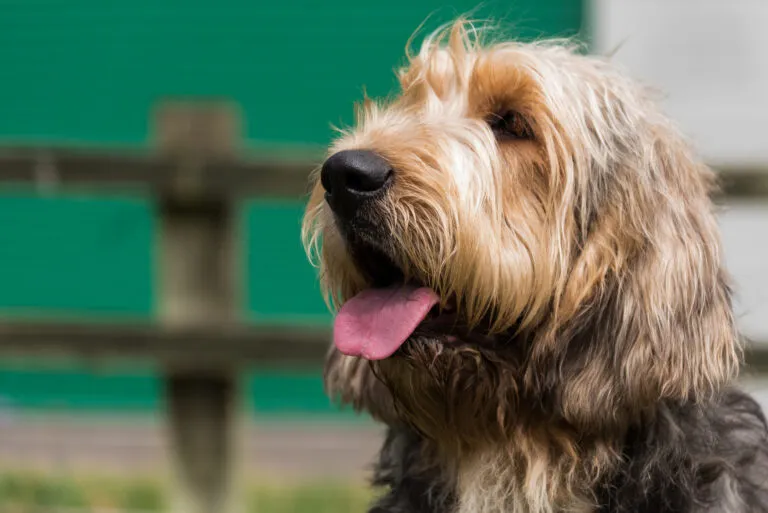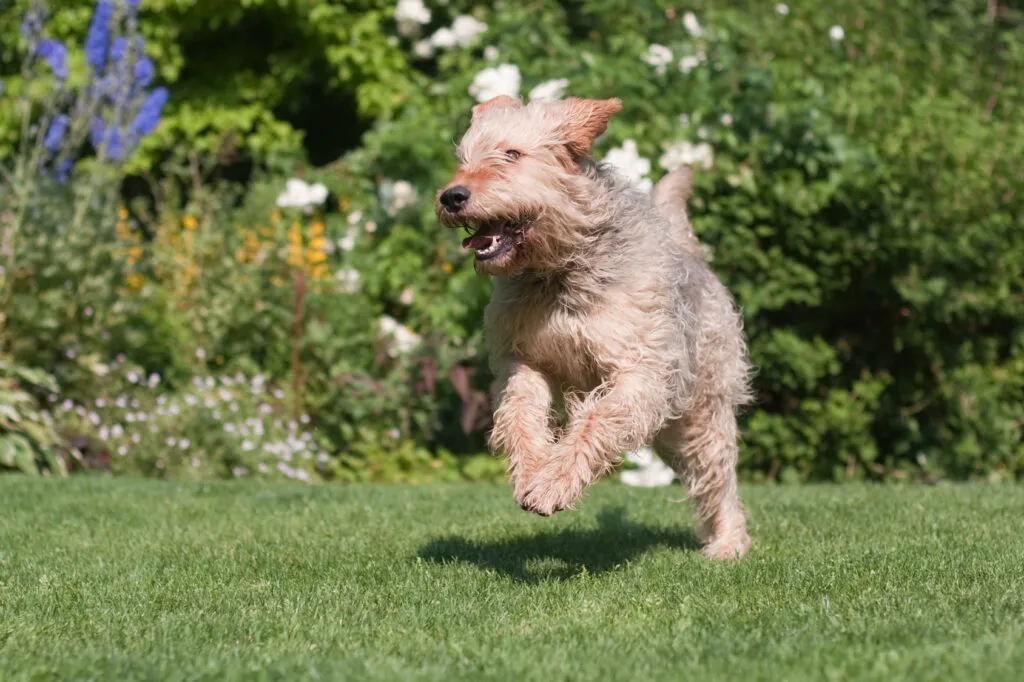Medium Size Poodle
The "Otti", as the Otterhound is affectionately called by its fans, is surely one of the friendliest hunting dogs. However, its charming stubbornness and strong hunting passion make it a companion best suited for experienced dog owners who have a bit of patience.

© lourdesphoto / stock.adobe.com
The Otterhound’s oily coat, large paws, and long ears are perfectly suited for its original role as a water-tracking scent hound
Many might mistake the Otterhound for a mixed breed because of its original look. However, its appearance is perfectly suited for its original task. With a height of around 69cm at the shoulder – 61cm for females – it can wade through water where smaller dogs would struggle.
Its rough, medium-length, slightly oily fur is ideal for water outings, as are its large paws that make movement in the water easier. It carries its long rod downwards, along with large floppy ears.
The variety of colours is extensive, including black, black and tan, wheat-coloured, blue and cream, liver and sand-coloured, and grey.
As the name suggests, the Otterhound is an otter hunter. In 19th-century Britain, otter hunting was conducted to protect fish ponds. For some dog owners, hunting otters was simply a pastime or a way to obtain the pelts of these water-dwelling animals.
The origins of this dog lie in Britain, where it’s thought that French dogs were crossed with British hounds, including the Bloodhound, to create an effective water hunter. Bloodhounds have an exceptional sense of smell, which was passed on to the Otterhound.
The result was robust dogs that could spend hours in the water to catch prey. They tracked otters by following the animals’ air bubbles.
Their endurance remains a core trait: hunting in water could last up to five hours, and on land up to twelve.
When an Otterhound spotted potential prey, it would signal with a bark. The peak of the Otterhound’s popularity lasted only a few decades. The breed emerged in the 19th century but declined by its end due to the reduction of huntable otters.
Only in 1979 was the breed officially recognised by the FCI. Nowadays, otter hunting is prohibited for conservation reasons, and the Otterhound has become rare. Those still with hunters are used for tracking wounded game. The breed is listed as endangered in Britain, with fewer than 1,000 worldwide.
This scarcity has led to strong networks among breeders to ensure the breed’s preservation.
Friendly with children, cheerful, and always eager for activities, the Otterhound is a delightful dog, making it attractive to families. However, its suitability is limited: the Otterhound is strong-willed and often prioritises its desires over its owner’s. It’s not the best choice for those seeking an obedient dog.
It’s not an ideal guard or protection dog, although its imposing presence might deter intruders. Social and good-natured, the breed gets along well with other dogs.
Training an Otterhound requires patience and a good sense of humour. This willful hunter learns only what it wants to learn. Basic training can be successfully taught, but it does not favour strict obedience or many commands.
If it finds things too tedious, it will simply ignore you. When it sets its mind on something, it will persistently pursue it.
The key is balancing the right amount of obedience with the freedom for the Otterhound to express its stubborn nature. Puppy training schools are recommended, especially those experienced with similar breeds, like Beagles.
The Otterhound remains friendly and won’t try to dominate as the pack leader, but training gaps can lead to bad habits or an inability to recall. Given that they can weigh up to 50kg, this can be problematic, even for leashed dogs.
 © Christian Müller / stock.adobe.com
© Christian Müller / stock.adobe.com
The Otterhound is generally robust, but its small genetic pool of around 1,000 worldwide poses a risk. Good cooperation among breeders is essential to maintain genetic health. Before acquiring a puppy, ensure the breeder minimises genetic risks from close inbreeding.
There’s also a predisposition to elbow and hip dysplasia. Ensure the parent dogs have appropriate health certifications before breeding. Maintain a healthy weight for your dog to protect its joints into old age.
Otterhounds are also prone to epilepsy, for which there are no pre-screening tests. Breeders should conduct thorough pedigree research before breeding decisions.
What is the optimal diet for the Otterhound? For growing Otterhounds, ensure they do not receive overly rich food, which can cause too rapid growth, harming their joints. While puppies may need up to four meals a day, adult Otterhounds usually need just two, followed by a rest period to prevent dangerous gastric torsion.
Opinions on the best food vary, but some criteria indicate high-quality pet food: a high meat content and the absence of grain fillers. Avoid sugar in treats; instead, reward your dog with affection, dental hygiene snacks, or occasionally with dried chews, like tripe, to keep them occupied.
Regularly brush your Otterhound’s rough fur – you’ll also catch small items like leaves and twigs that may get caught in its thick undercoat. During these sessions, check its floppy ears, as their shape can lead to infections. Keep care tools like ear cleaners, tick removers, and nail clippers on hand for quick access.
Most dirt will brush out of dry fur, but it’s good to accustom your pet to baths, as home baths differ from lake swims. Use a mild dog shampoo and keep your Otterhound warm afterwards to prevent chills. Only bathe when necessary.
Avoid trimming. Use dental hygiene snacks or raw beef for dental care. Some owners brush their dogs’ teeth with dog toothpaste, which, although time-consuming, prevents tartar effectively.
An Otterhound loves long nature walks and swimming. Regular swimming outings are ideal, although safe areas might be hard to find, especially since they may not always come when called. If kept as a family pet, provide ample activities: Flyball or agility are exciting sports for the Otterhound.
Any nose work is enjoyable, and they can track scents days old. Train them to find items or try mantrailing – your four-legged detective will be delighted! However, this fun activity takes time and training.
In the first year, avoid intense running, jumping, or stairs to reduce the risk of hip dysplasia. Running, swimming, or trotting alongside a bike provide good exercise for an adult Otterhound. Some are friendly enough to serve as therapy dogs.
Do you have dog experience, patience, a fenced property in a green area, and plenty of time for your four-legged companion? Then you might consider an Otterhound. Before deciding, network with other Otterhound owners and meet as many dogs as possible – the charming dog’s stubbornness isn’t suitable for everybody.
Despite its hunting instinct, the Otterhound can be a family dog, marked by remarkable friendliness. It loves playing with children and builds good friendships with them. Good with other dogs, it’s traditionally kept in packs.
Strangers can expect a bark, but that’s about the extent of its guarding skills. Consider the time and expenses required for a new dog, as such a commitment carries significant responsibility.
Most are in Britain and the USA, some in Finland and the Netherlands. Expect waiting times and travel, and do some research before your desired Otterhound can join you. You might end up on a waiting list, requiring patience. Look for clubs or fan groups focused on Otterhounds. Such organisations can also help if you’re seeking an adult Otterhound.
While rare, some do lose their homes occasionally. Alternatively, consider a mixed breed from a shelter or another breed suited for you, as finding a purebred adult Otterhound in adoption is a stroke of luck. Explore local animal shelters where larger dogs often await homes – maybe one will capture your heart.
We wish you much delight with your friendly, stubborn companion, the Otterhound!
Fans of the Bearded Collie agree that those who aren't familiar with this dog breed simply have to get acquainted with it. And those who have experienced how a Bearded Collie bolts across meadows with its flowing fur, how it rolls around full of energy and joy and how it attentively and observantly takes into account its owners wishes become simply addicted to this original dog breed and its unique charm.
The Goldendoodle isn't a breed, but a pairing between Golden Retrievers and Medium or Standard Poodles. Marketed as a low-maintenance dog for allergy sufferers, this hybrid is enjoying increasing popularity amongst dog lovers, similar to the Labradoodle.